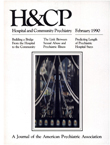Predicting Length of Hospital Stay for Psychiatric Inpatients
Abstract
Medicare's use of diagnosis-related groups and the frequent acceptance of lengt of stay as an indicator of resource utilization has caused a surge of interest in the predictability of length of hospital stay for psychiatric inpatients. By constructing a weighted least squares regression model using data from the 1980 Hospital Discharge Survey, the authors were able to account for an increased amount of variance in length of stay for the major diagnostic categories of mental disorder and substance abuse for Medicare and Blue Cross/Blue Shield patients. The enhanced ability to predict length of stay is attributed to a carefully constructed data base and an increased number of predictor vanables, particularly comorbidity. Knowledge of the presence or absence of a chemical dependency unit in the hospitals from which patients were discharged substantially increased the proportion of variance accounted for in the analysis.
Access content
To read the fulltext, please use one of the options below to sign in or purchase access.- Personal login
- Institutional Login
- Sign in via OpenAthens
- Register for access
-
Please login/register if you wish to pair your device and check access availability.
Not a subscriber?
PsychiatryOnline subscription options offer access to the DSM-5 library, books, journals, CME, and patient resources. This all-in-one virtual library provides psychiatrists and mental health professionals with key resources for diagnosis, treatment, research, and professional development.
Need more help? PsychiatryOnline Customer Service may be reached by emailing [email protected] or by calling 800-368-5777 (in the U.S.) or 703-907-7322 (outside the U.S.).



